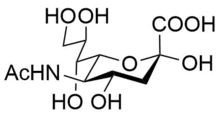N-Acetylneuraminic acid
N-Acetylneuraminic acid (Neu5Ac or NANA) is the predominant sialic acid found in human cells, and many mammalian cells. Other forms, such as N-Glycolylneuraminic acid, may also occur in cells.
 | |
| Names | |
|---|---|
| IUPAC name
5-(acetylamino)-3,5-dideoxy-D-glycero-α-D-galacto-non-2-ulopyranosonic acid | |
Other names
| |
| Identifiers | |
3D model (JSmol) |
|
| ChEBI | |
| ChemSpider | |
| ECHA InfoCard | 100.004.568 |
| MeSH | N-Acetylneuraminic+Acid |
PubChem CID |
|
| UNII | |
CompTox Dashboard (EPA) |
|
| |
| |
| Properties | |
| C11H19NO9 | |
| Molar mass | 309.273 g/mol |
| Appearance | White crystalline powder |
| Melting point | 186 °C (367 °F; 459 K) (decomposes) |
| Pharmacology | |
| M09AX05 (WHO) | |
Except where otherwise noted, data are given for materials in their standard state (at 25 °C [77 °F], 100 kPa). | |
| Infobox references | |
This residue is negatively charged at physiological pH and is found in complex glycans on mucins and glycoproteins found at the cell membrane. Neu5Ac residues are also found in glycolipids, known as gangliosides, a crucial component of neuronal membranes found in the brain.
Along with involvement in preventing infections (mucus associated with mucous membranes—mouth, nose, GI, respiratory tract), Neu5Ac acts as a receptor for influenza viruses, allowing attachment to mucous cells via hemagglutinin (an early step in acquiring influenzavirus infection).
In the biology of bacterial pathogens
Neu5Ac is also important in the biology of a number of pathogenic and symbiotic bacteria[1][2] as it can used either as a nutrient, providing both carbon and nitrogen to the bacteria, or in some pathogens, can be activated and placed on the cell surface.[1] Bacteria have evolved transporters for Neu5Ac to enable them to capture it from their environment and a number of these have been characterized including the NanT protein from Escherichia coli,[3] the SiaPQM TRAP transporter from Haemophilus influenzae[4] and the SatABCD ABC transporter from Haemophilus ducreyi.[5]
References
- Severi E, Hood DW, Thomas GH (2007). "Sialic acid utilization by bacterial pathogens". Microbiology. 153 (9): 2817–2822. doi:10.1099/mic.0.2007/009480-0. PMID 17768226.
- Vimr ER, Kalivoda KA, Deszo EL, Steenbergen SM (2004). "Diversity of microbial sialic acid metabolism". Microbiol Mol Biol Rev. 68 (1): 132–153. doi:10.1128/mmbr.68.1.132-153.2004. PMC 362108. PMID 15007099.
- Vimr ER, Troy FA (1985). "Identification of an inducible catabolic system for sialic acids (nan) in Escherichia coli". J. Bacteriol. 164 (2): 845–853. PMC 214328. PMID 3902799.
- Severi E, Randle G, Kivlin P, Whitfield K, Young R, Moxon R, Kelly D, Hood D, Thomas GH (2005). "Sialic acid transport in Haemophilus influenzae is essential for lipopolysaccharide sialylation and serum resistance and is dependent on a novel tripartite ATP-independent periplasmic transporter". Mol. Microbiol. 58 (4): 1173–1185. doi:10.1111/j.1365-2958.2005.04901.x. PMID 16262798.
- Post DM, Mungur R, Gibson BW, Munson RS Jr (2005). "Identification of a novel sialic acid transporter in Haemophilus ducreyi". Infect Immun. 73 (10): 6727–35. doi:10.1128/IAI.73.10.6727-6735.2005. PMC 1230923. PMID 16177350.